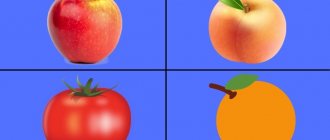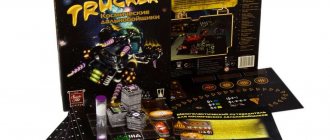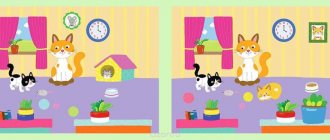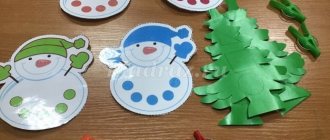“AUTHOR’S D/GAMES on healthy lifestyle”
All-Russian CONTINUALLY professional competition for teachers of preschool organizations “Healthy lifestyle in preschool educational institutions”
Agarkova Tatyana Vasilievna , teacher
Biryukova Valentina Vasilievna , teacher
Sviridova Zhanna Anatolyevna , teacher - defectologist
(typhlopedagogue)
MBDOU d/s combined
view No. 6, Belgorod
Advertising message
“A healthy lifestyle is great!”
“Taking care of health is the most important job of a teacher. Their spiritual life, worldview, mental development, strength of knowledge, and self-confidence depend on the cheerfulness and vigor of children.”
V.A. Sukhomlinsky.
A healthy lifestyle for preschool children is not only physical activity, but also a whole range of measures that should become a priority for the child’s parents. Until the age of 7, a child goes through a huge developmental path, during which both his physical health and personal qualities are established. They are interconnected with each other, which is why it is so important at the very beginning of life to form a base of knowledge and skills for a healthy lifestyle in the baby.
The main aspects aimed at improving the health of preschool children include:
– motor mode;
– personal hygiene;
– hardening.
In our work with children with severe visual impairments (blind and visually impaired children), we use various forms, means and methods of forming the foundations of a healthy lifestyle in preschoolers. The main forms of work are didactic games, creating situations, reading and discussing fiction, project and productive activities, walking, and routine moments. In the daily routine and in direct educational activities we use motor and emotional-psychological relief (physical training minutes, motor discharge, elements of relaxation).
Personal hygiene is extremely important for a child’s health. At the very beginning of life, the baby must learn that the body needs to be looked after. This is important not only for the good condition of the body, but also for the health of others. The child must have personal items: comb, toothbrush, towel and handkerchief. From childhood, you need to teach him how to use these items correctly.
We offer you original didactic games.
Author's didactic game:
“Learn and name personal hygiene items.”
Goal: To consolidate knowledge about personal hygiene items and their purpose, to develop tactile sensations, verbal and logical thinking, memory, and grammatical structure of speech.
Equipment: teaching aid “Guess It”, personal hygiene items – comb, toothbrush, toothpaste, soap, shampoo, washcloth, handkerchief, towel, scissors.
Game description:
The items are located inside the teaching aid.
Option No. 1: visually impaired children look at a picture depicting personal hygiene items, find and name personal hygiene items by touch and tell what they are for.
Option No. 2: blind children find personal hygiene items by touch and tell them what they are for.
Author's didactic game:
"Journey to the Land of Health"
Goal: To form children’s ideas about a healthy lifestyle
Equipment : playing field with pasted pictures, cube, colored chips (we have nesting dolls)
Description of the game : Players take turns throwing a die on the sides, which shows from 1 to 6 dots, moving their chip forward in as many circles as there are dots on the die. If the chip is in the picture, the child talks about what is shown in the picture and what rule must be followed in order to be healthy; if the answer is incorrect, the child skips a move; if the answer is correct, he takes the next one. If a chip lands on a circle with an arrow, then the player moves forward or backward along the arrow. The winner is the one who gets to the land of health first (to the finish line).
Homemade games for children in the middle group
Manufacturers of children's goods offer an increasingly diverse range of games and toys for early development. However, it is not necessary to use only purchased teaching materials. In many cases, homemade games and add-ons to store-bought sets may be suitable.
The teacher should not completely take upon himself all the hassle associated with the production of the elements necessary for the game. His task is to identify the goal and convey it to the parents. Conversations should emphasize the importance of their participation in the life of the group.
Note! Items made by mother's or father's hands are of great importance for any child and help his socialization among his peers.
Making educational games with your own hands
Parents can make elements that bring children's play closer to reality.
- Sew clothes and bed linen for the doll corner. Help in making masks for theatrical activities.
- To maintain interest in toys, some of the available games should be removed from the free access area into drawers and boxes covered with the same self-adhesive paper. It is convenient to use games in which small parts are not mixed together, but are placed in bags specially sewn for them. Parents can easily help decorate toy containers beautifully.
- The Seasons Corner is an important teaching material for which exhibits cannot be purchased. But natural materials and hand-made crafts are excellent for use.
Corner of the seasons
- The demonstration material will also be useful for studying local history. The teacher is unlikely to be able to purchase ready-to-use sets on the topics “My City”, “My Republic”, etc. Most likely, a card index is best suited for such activities, the pictures for which will be specially selected and printed.
Conducting games for middle group children
Starting from the middle group, a child attending kindergarten is engaged in activities aimed at his personal development.
Lesson in kindergarten
Didactic games for preschool age in preschool educational institutions
Along with tasks in mathematics and speech development, children have the opportunity to learn to draw and sculpt in creative art classes. An important feature of such activities should be a frequent change of activity, in which children have the opportunity to alternate sedentary intellectual activities with active games and physical exercises.
Important to remember! A well-planned educational process will avoid overwork, will not cause boredom and will help to achieve the highest possible results.
Finger drawing technique
Goals and objectives of gaming activities in the middle group
A 4-5 year old child must have certain skills and concepts. At this age, the main activity is play. That is why it is important to adhere to a playful form of learning, which will influence the formation of qualities and skills necessary for the development of attention and thinking:
- presence of an active vocabulary;
- the ability to express thoughts using coherent speech;
- ability to distinguish and describe objects (shape, color, size);
- understanding of numbers and quantity;
- the desire to compare and generalize concepts or objects;
- strengthening abilities aimed at concentrating;
- memory development.
Important point! A game activity should help consolidate what has been learned and at the same time serve as an impulse that encourages children to learn about topics that are new to them.
How didactic games are conducted in the middle group
Games should not be too simple, as this will cause boredom and reluctance to practice. But you shouldn’t make classes too complicated. Questions and assignments must correspond to the developmental characteristics of a given period of life. This will help stimulate the desire to learn new things and achieve visible results.
How to create a motivating environment
At the age of 3-5 years, children react with great interest to fairy tales and magical manifestations. Any activity can be carried out in the form of fairy-tale adventures, meetings with animated heroes, or travel to a magical land.
We must not forget! Excessive mobility is another distinctive feature of this age. You cannot abuse the child’s attention and delay intellectual work. Be sure to alternate sedentary activities that require increased concentration with outdoor games.
Didactic games for the middle group
Through play, children become familiar with the world around them and develop good habits and concepts. During the didactic game, adults teach four-year-old children to engage in joint cognitive activities.
Peculiarities
A child aged 4-5 years is distinguished by an inexhaustible supply of curiosity and a desire to get answers to many questions that interest him. It is at this age that a significant growth in the baby’s abilities is manifested. According to the observations of psychologists, thinking during this period becomes more imaginative, and the psyche is more stable compared to previous years of life.
Differences
In the middle group, object games fade into the background, although they still remain relevant. To a greater extent, they are aimed at consolidating familiar concepts.
They are gradually being replaced by board-printed and word games. During this period, the active formation of FEMP* begins.
Math lesson



